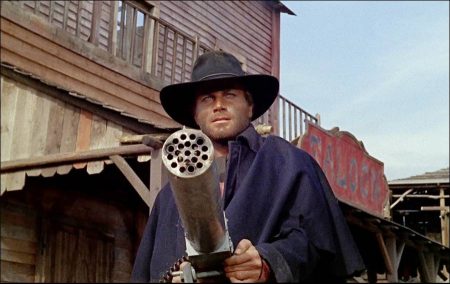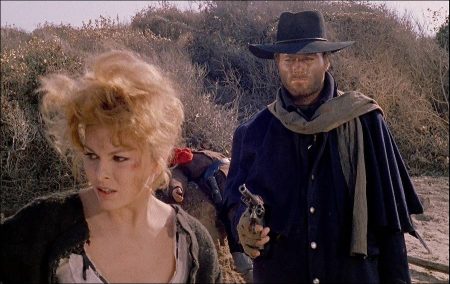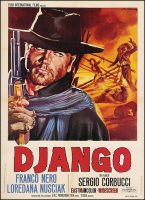Django movie storyline. Walking through the desert dragging a coffin, a lonely cowboy rescues Maria from a group of bandits. That cowboy is Django, and he arrives in a muddy ghost town ravaged by those bandits, where only the saloon and the brothel, owned by Nataniele, are open.
Soon, Major Jackson, who charges protection fees from the dwellers, rounds his gang up to face Django, but he kills all the bandits but Jackson using a machine gun. Then a mercenary and acquaintance of Django, Gen. Hugo Rodriguez, arrives in town, and Django proposes a bold plan to steal the gold from Jackson and split between them. When Django is betrayed, he steals the gold from Hugo and is helped by Maria. They are chased by Hugo and his men, while Jackson organizes with the Mexican army to trap Hugo.
Django is a 1966 Italian Spaghetti Western film directed and co-written by Sergio Corbucci, starring Franco Nero (in his breakthrough role) as the title character alongside Loredana Nusciak, José Bódalo, Ángel Álvarez and Eduardo Fajardo. The film follows a Union soldier-turned-drifter and his companion, a mixed-race prostitute, who become embroiled in a bitter, destructive feud between a gang of Confederate Red Shirts and a band of Mexican revolutionaries. Intended to capitalize on and rival the success of Sergio Leone’s A Fistful of Dollars, Corbucci’s film is, like Leone’s, considered to be a loose, unofficial adaptation of Akira Kurosawa’s Yojimbo.
The film earned a reputation as one of the most violent films ever made at the time, and was subsequently refused a certificate in the United Kingdom until 1993, when it was issued an 18 certificate (the film was downgraded to a 15 certificate in 2004). A commercial success upon release, Django has garnered a large cult following outside of Italy and is widely regarded as one of the best films of the Spaghetti Western genre, with the direction, Nero’s performance, and Luis Bacalov’s soundtrack most frequently being praised.
Although the name is referenced in over 30 “sequels” from the time of the film’s release until the early 1970s in an effort to capitalize on the success of the original, most of these films were unofficial, featuring neither Corbucci nor Nero. Nero reprised his role as Django in 1987’s Django Strikes Again, the only official sequel produced with Corbucci’s involvement. Nero also made a cameo appearance in Quentin Tarantino’s 2012 film Django Unchained, as homage to Corbucci’s original. John Sayles is working on a third official instalment in the film series, with Nero reprising his role.
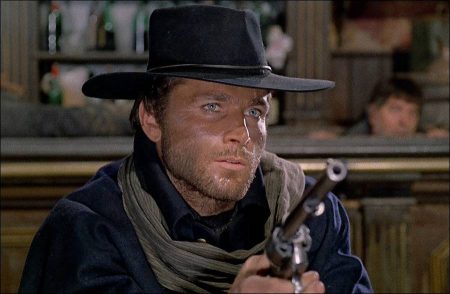
About the Story
On the Mexico-United States border, a drifter, wearing a Union uniform and dragging a coffin, witnesses Mexican bandits tying a runaway prostitute, María, to a bridge and whipping her. The bandits are dispatched by henchmen of Major Jackson – a racist ex-Confederate officer – who is preparing to kill María by crucifying her atop a burning cross.
The drifter, who identifies himself as Django, easily shoots the men, and offers María protection. The pair arrive in a ghost town, populated by Nathaniel, a bartender, and five prostitutes. Nathaniel explains that the town is a neutral zone in a conflict between Jackson’s Red Shirts and General Hugo Rodríguez’s revolutionaries.
Jackson and his men arrive at the saloon to extract protection money from Nathaniel. Django verbally confronts two Klansmen when they harass a prostitute, and ridicules Jackson’s beliefs. Django then shoots his men, and challenges Jackson to return with all of his accomplices. Afterwards, he seduces María when she thanks him for his protection.
Jackson returns with his entire gang. Using a machine gun contained in his coffin, Django guns down much of the Klan, allowing Jackson and a handful of men to escape. While helping Nathaniel bury the corpses, Django visits the grave of Mercedes Zaro, his former lover who was killed by Jackson. Hugo and his revolutionaries arrive and capture Jackson’s spy, Brother Jonathan. As punishment, Hugo cuts off Jonathan’s ear, forces him to eat it, and shoots him in the back. Later, Django proposes to Hugo, who he had once saved in prison, that they steal Jackson’s gold, currently lodged in the Mexican Army’s Fort Charriba.
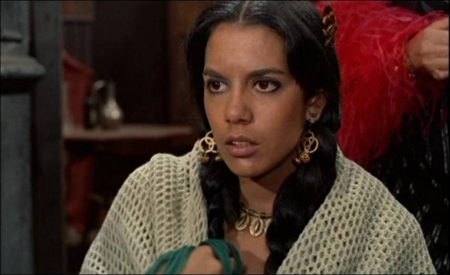
Nathaniel, under the guise of bringing prostitutes for the soldiers, drives a horse cart containing Django, Hugo and four revolutionaries, two of whom are named Miguel and Ricardo, into the Fort, allowing them to massacre many of the soldiers – Miguel uses Django’s machine gun, while Django, Hugo and Ricardo fight their way to the gold. As Django and the revolutionaries escape, Jackson gives chase, but is forced to stop when the thieves reach American territory. Django asks for his share of the gold, but Hugo, wanting to use it to fund his attacks on the Mexican Government, promises to pay Django once he is in power.
When Ricardo tries to force himself onto María during the post-heist party, a fight erupts between Django and Ricardo, resulting in the latter’s death. Hugo allows Django to spend the night with María, but he chooses another prostitute. Django has the prostitute distract the men guarding the safehouse containing the gold, and enters the house via the chimney. Stealing the gold in his coffin and activating his machine gun as a diversion, Django loads the coffin onto a wagon. María implores Django to take her with him.
Arriving at the bridge where they first met, Django tells María that they should part ways, but María begs him to abandon the gold so they can start a new life together. When María’s rifle misfires, the coffin falls into the quicksand below. Django nearly drowns when he tries to recover the gold, and María is wounded by Hugo’s men while trying to save him. Miguel crushes Django’s hands as punishment for being a thief, and Hugo’s gang leave for Mexico. Upon arrival, the revolutionaries are massacred by Jackson and the army. Django and María return to the saloon, finding only Nathaniel there, and Django tells them that, despite his crushed hands, he must kill Jackson to prevent further bloodshed.
Jackson learns that Django is waiting for him at Tombstone Cemetery and kills Nathaniel, but not before the latter hides María. Django, resting himself on the back of Mercedes Zaro’s cross, pulls the trigger guard off his revolver with his teeth and rests it against the cross, just as Jackson’s gang arrive. Believing that Django cannot make the sign of the cross with his mutilated hands, Jackson shoots the corners of Zaro’s cross. Django then kills Jackson and his men by pushing the trigger against the cross and repeatedly pulling back the hammer. Leaving his pistol on Zaro’s cross, Django staggers out of the cemetery, ready to start a new life with María.
Django (1966)
Directed by: Sergio Corbucci
Starring: Franco Nero, Loredana Nusciak, José Bódalo, Ángel Álvarez, Eduardo Fajardo, Giovanni Ivan Scratuglia, Simón Arriaga, Remo De Angelis, José Canalejas, Luciano Rossi, Yvonne Sanson, Guillermo Méndez
Screenplay by: Sergio Corbucci, Bruno Corbucci, Franco Rossetti, José Gutiérrez Maesso, Piero Vivarelli
Production Design by: Carlo Simi
Cinematography by: Enzo Barboni
Film Editing by: Nino Baragli, Sergio Montanari
Costume Design by: Carlo Simi
Set Decoration by: Francisco Canet
Art Direction by: Carlo Simi
Music by: Luis Enriquez Bacalov
MPAA Rating: None.
Distributed by: Euro International Film
Release Date: April 5, 1966
Views: 348
